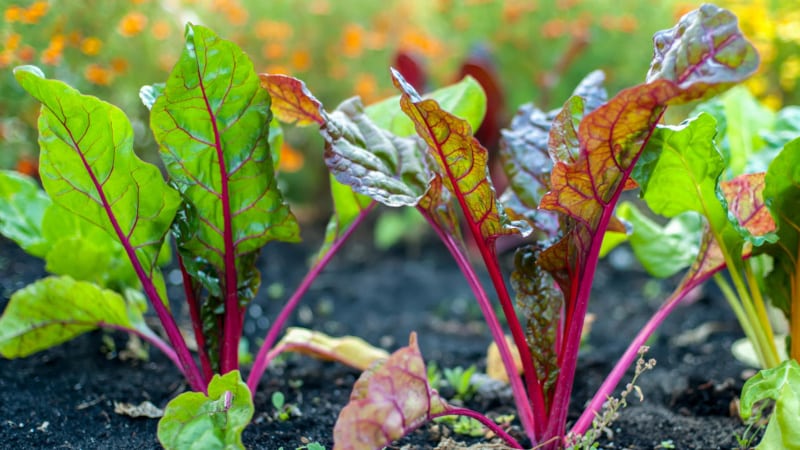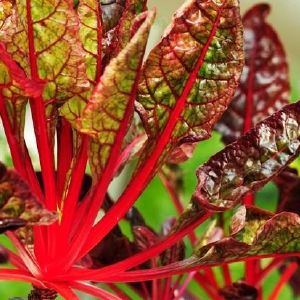Why do beet leaves turn red and what to do about it?
Beetroot have been eaten for thousands of years. Initially, dishes were prepared only from beet tops, and root vegetables were not eaten. At first, the healthy vegetable was cultivated only on the islands of the Mediterranean Sea. Late beets have spread to all continents
The culture is unpretentious and does not require special care. However, difficulties arise in the process of growing it. An indicator of the health and proper development of a vegetable is the condition of the tops. Errors in care lead to the leaves drying out, changing color, and becoming stained. In this article we will figure out why beet leaves turn red and how to feed the vegetable if it is stunted in growth.
Causes of red beet leaves

Redness of the tops does not always signal an unhealthy vegetable. Eat beet varieties, a distinctive feature of which is the reddish tint of the leaves (Sugar and Burgundy varieties). In this case, an unusual color of the tops is the norm. Such features of the variety are indicated by the seed manufacturer on the packaging, so before planting you should carefully study all the information on the package.
If the selected variety does not have such a characteristic feature, then redness of the tops indicates a violation of the rules of care or disease of the root crops. There are several reasons for this phenomenon.
Insufficient sodium content in the soil
Normal sodium content in the soil is important during the initial phases of plant growth and development. Young beet sprouts absorb sodium, calcium and magnesium from the ground especially intensively.A lack of sodium negatively affects the development of plants, preventing them from absorbing sufficient amounts of phosphorus and nitrogen.
Sodium enhances the growth of tops, increases enzymatic activity, and promotes the accumulation of sugar in root vegetables.
Insufficient content of potassium and phosphorus in the soil
Another reason for the appearance of burgundy leaves lies in the lack of potassium and phosphorus. If the beet leaves turn dark red at the edges, this indicates insufficient potassium content in the soil. This phenomenon is also called beet edge necrosis. In cases of acute potassium deficiency, the leaves of plants curl and dry out.
With phosphorus deficiency, the tops first acquire a dark green color, and after some time become red.
Increased soil acidity
Beetroot is sensitive to soil acidity. Increased acidity is the most common cause of red and purple leaves in beet beds.
Attention. In acidic soil, beets grow unsightly small leaves, and root crops develop poorly.
Testing soil acidity is easy at home. For this purpose, special acidity analyzers, which are sold in gardening centers (litmus paper, Alyamovsky device, soil composition analyzers), are suitable.
Traditional methods include testing with vinegar and hydrochloric acid. Such methods are not so reliable, but are quick to use and accessible. A lump of soil from the garden is watered with strong hydrochloric acid or table vinegar. If the wetted soil reacts with the formation of bubbles, then the soil is alkaline. If there is no reaction, it is neutral or sour.
Ways to solve the problem
What should you do if the tops turn red and the root crop itself grows poorly? How to determine what a vegetable lacks and what to water the beds with to solve the problem? Depending on the cause of reddening of the foliage, the following measures are applied.
The sodium content in the soil is increased in a simple way. Beet plantings are watered with water and salt (200 g of table salt per 10 liters of water). For 1 m² of beds use 1-2 liters of solution. In this case, watering is carried out not at the root, but directly along the tops.
Attention. Excessive sodium content in the soil, which is typical for alkaline soils, has a detrimental effect on beet yield.
Applying appropriate fertilizers will help compensate for the lack of potassium and phosphorus in the soil. Regular fertilizing increases the yield of root crops by 1.5 times. When applying fertilizers, it is important to follow the dosages recommended by the manufacturer. Excess nutrients lead to the accumulation of nitrates in fruits.
Need to know. Applying potassium-phosphorus fertilizers to acidic soil does not give the desired effect. In an acidic environment, phosphorus turns into compounds that are difficult to assimilate and is not absorbed by plants.
Wood ash helps reduce soil acidity. It is sprinkled generously on beet beds. It is good to combine fertilizing with watering. To prepare the solution, 2-3 cups of wood ash are mixed with 10 liters of water. Before watering, the solution is thoroughly mixed.
To reduce acidity in the fall, when digging the garden, dolomite flour and chalk (500 g per 1 m²) are added to the soil.
Proper care of beets
It is impossible to grow a rich harvest of root crops without proper plant care. Beds with beets need weed removal and loosening, thinning, watering, and fertilizing.
Removing weeds and loosening the soil
The threat posed by weeds is great at the initial stage of crop growth. Until a rosette of 4-6 leaves forms, beets grow slowly. Without proper care, weeds will prevent young plants from growing.
Removing weeds is combined with loosening the top layer of soil. This procedure increases gas exchange in the upper layer of soil and helps retain moisture.
Thinning
Beet seeds are prolific, that is, one seed produces from 2 to 4 plants, so thinning cannot be avoided.
Densely growing fruits take away resources from each other, which has a bad effect on the yield, size and quality of root crops. The root system of beets grown without thinning is small and underdeveloped.
Advice. Replant healthy plants discarded during thinning into free space. Beets tolerate transplants well.
The first thinning is carried out when the first 2 full-fledged leaves have formed on young plants. At this stage, a distance of 2-3 cm is left between the seedlings in the row.
Thinning is repeated when a rosette of 5-6 leaves has formed on the plants. Now between plants an interval of 4-6 cm is maintained.
The beets are thinned out for the last time in early August. This time, gaps of 8-10 cm are left between plants.
Failure to comply with thinning deadlines negatively affects the quantity and quality of the harvest. The optimal time for the procedure is after watering or heavy rain. Plants are easier to remove from moist soil, and transplanted specimens will more easily take root in a new location.
Watering
Beetroot grows well in evenly moist soil, but without excess moisture. In dry summers, beet beds are watered regularly and abundantly.The vegetable is especially demanding of watering at the beginning of growth and at the stage of active increase in fruit mass.
Attention. Mulching the topsoil will maintain soil moisture and structure. This technique reduces the number of waterings and simplifies maintenance.
In August, watering is reduced, and 2-3 weeks before harvesting, it is stopped. This way the root vegetables will accumulate more sugars and taste better.
Fertilizer application
They begin to fertilize beets when young plants have 3-4 leaves. Dry fertilizers are applied between rows simultaneously with loosening. Approximately 8 g of potassium salt and 7-9 g of ammonium nitrate are used per 1 m².
The second time, fertilizers are applied shortly before the rows are closed. This time more fertilizers are applied: per 1 m² - 16-20 g of potassium fertilizers and 10-15 g of nitrogen fertilizers.
Read also:
Favorite by farmers for its ease of care and taste, the “Cylinder” variety of table beets.
Conclusion
Healthy, bright green foliage is key to a good beet harvest. If the tops change color, dry out, or curl, it means that the root crops do not have enough nutrients. Another possible reason is increased soil acidity. Proper and regular application of fertilizers, as well as liming the soil (if necessary), will avoid such problems as reddening of beet leaves.